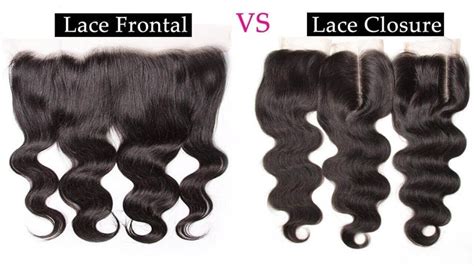In the realm of hair extensions, lace frontals and lace closures reign supreme. Both methods offer versatility and natural-looking results, but they differ in several key aspects. Here’s an in-depth comparison to help you choose the best option for your unique style:

1. Coverage and Customization
Lace Frontal:
Covers the entire hairline, from ear to ear.
Provides the most extensive coverage, allowing for multiple partings and styling options.
Lace Closure:
Covers a smaller area, typically 4×4 inches or 5×5 inches.
Offers limited coverage but is ideal for creating a more natural part.
2. Installation and Maintenance
Lace Frontal:
Requires more time and expertise to install.
Needs to be blended seamlessly with your natural hair to achieve a flawless look.
Maintenance is more frequent, as it’s prone to damage and requires regular glue-ups.
Lace Closure:
Easier and less time-consuming to install.
Blends more easily with existing hair, making it less detectable.
Requires less frequent maintenance, as it protects your natural hair underneath.
3. Versatility and Styling
Lace Frontal:
Provides unlimited styling versatility.
Allows for high ponytails, braids, updos, and more.
Lace Closure:
Offers limited styling options due to the smaller coverage area.
Best suited for styles that keep the hair down or cover the closure area.
4. Cost and Lifespan
Lace Frontal:
Typically more expensive than lace closures due to its extensive coverage.
Has a shorter lifespan than lace closures, requiring more frequent replacements.
Lace Closure:
More affordable than lace frontals.
Lasts longer, as it covers a smaller area and is less prone to damage.
Decision Time: Which to Choose?
The choice between a lace frontal and a lace closure ultimately depends on your individual needs and preferences. Consider these key factors:
- Coverage: Do you prefer extensive coverage for multiple partings or a more natural-looking part?
- Installation: Are you comfortable with more complex installation and maintenance processes?
- Styling: Do you prioritize versatility in styling or prefer styles that keep the hair down?
- Budget: Are you willing to invest in a more expensive and higher-maintenance option?
For beginners, a lace closure might be a more suitable choice due to its easier installation and more natural appearance.
Unifying Lace: A Novel Application of Lace Closures and Frontals
Beyond the traditional applications in hair extensions, lace closures and frontals can also be creatively repurposed for a variety of other uses. Consider these innovative ideas:
- Lace Dresses and Tops: Create elegant and ethereal garments by attaching lace closures or frontals to fabric.
- Headbands and Accessories: Enhance plain headbands and accessories with decorative lace details.
- Lace Curtains and Window Treatments: Transform your windows into stunning focal points with curtains or blinds made from lace closures or frontals.
- Decorative Wall Hangings: Create unique and eye-catching wall art by framing lace closures or frontals in shadow boxes.
Lace Closures and Frontals: Empowering Your Style
Whether you’re seeking natural-looking hair extensions or exploring creative new applications, lace closures and frontals offer endless possibilities. With their versatility and customization options, these tools empower you to transform your style and unleash your individuality.
1. How long do lace frontals and lace closures last?
Lace frontals typically last 6-8 months with proper care, while lace closures can last up to a year.
2. Can I bleach or dye lace frontals and lace closures?
Yes, but it’s recommended to seek professional help to avoid damage.
3. Are lace frontals and lace closures comfortable to wear?
Yes, when installed properly, both options are comfortable and undetectable.
4. Can I wear my lace frontal or lace closure in water?
Yes, but avoid chlorine pools and saltwater, as these can damage the lace.
5. How long does it take to install a lace frontal or lace closure?
Installation times vary depending on the method used, but typically take 2-4 hours.
6. What are the best products to use on lace frontals and lace closures?
Use products specifically designed for lace extensions, such as sulfate-free shampoos, conditioners, and leave-in treatments.
7. How often should I wash my lace frontal or lace closure?
Every 7-10 days, depending on how often you wear it and how much product you use.
8. What is the best way to remove a lace frontal or lace closure?
Use a gentle adhesive remover and follow the instructions carefully to avoid damage.
Table 1: Coverage and Versatility
| Type | Coverage | Versatility |
|---|---|---|
| Lace Frontal | Extensive, from ear to ear | Unlimited |
| Lace Closure | Smaller, typically 4×4 or 5×5 inches | Limited |
Table 2: Installation and Maintenance
| Type | Installation | Maintenance |
|---|---|---|
| Lace Frontal | More complex and time-consuming | More frequent, requires regular glue-ups |
| Lace Closure | Easier and less time-consuming | Less frequent, as it protects natural hair |
Table 3: Cost and Lifespan
| Type | Cost | Lifespan |
|---|---|---|
| Lace Frontal | More expensive | Shorter, requires more frequent replacements |
| Lace Closure | More affordable | Longer, lasts up to a year |
Table 4: Unifying Lace: Creative Applications
| Application | Materials |
|---|---|
| Lace Dresses and Tops | Lace closures or frontals, fabric |
| Headbands and Accessories | Lace closures or frontals, plain headbands |
| Lace Curtains and Window Treatments | Lace closures or frontals, curtain rods |
| Decorative Wall Hangings | Lace closures or frontals, shadow boxes |
